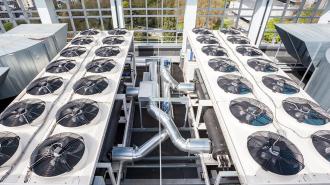As the world’s climate continues to heat up, the global demand for air conditioning is now skyrocketing. In 2019, the need for cooling drew in 8.5% of the world’s total electricity consumption, equating to some 1 billion tons of CO2 emissions.
As more air conditioning units draw ever more power each year, we now appear trapped in a cycle, only accelerating the problem of global heating further.
Cooling without power: One possible way to break this cycle could lie with passive cooling.
This kind of technology absorbs heat from the surrounding environment, and then exploits physical effects including insulation, evaporation, and radiation to transfer this heat away from the system being cooled – all without any added power.
As more air conditioning units draw more power, we now appear trapped in a cycle, only accelerating the problem of global heating.
There is still a long way to go before passive cooling systems can be rolled out on commercial scales, though. Not only do existing designs have a limited cooling performance, they also tend to use large amounts of water, and their efficiency is limited and dependent on environmental conditions, such as heat and humidity.
Three cooling layers: A team of researchers in Massachusetts has just made important steps towards overcoming these challenges. Within a flat, three-layered panel, Zhengmao Lu and colleagues at MIT combined several passive cooling techniques — each counteracting the shortcomings of the others.
The panel’s top layer features a highly insulating aerogel: an ultra-light, sponge-like material, featuring sparse networks of cross-linked polymers, where a vast majority of the volume is taken up by empty space. This structure makes aerogels highly insulating to heat, while allowing gases and other kinds of radiation to readily pass through.
Underneath the aerogel, Lu’s team incorporated a hydrogel: a material featuring a similar network of insoluble polymers, this time immersed in water. This layer is insulated by the aerogel above, but as the heat energy that does make it through the top layer is absorbed, the water it contains is partly evaporated into vapor – which rises up through the aerogel.
Passive cooling absorbs heat, and then uses insulation, evaporation, and radiation to transfer this heat away from the system being cooled without any added power.
In addition, the hydrogel converts some of the heat it absorbs into infrared radiation. Since both the aerogel and Earth’s atmosphere are transparent to this radiation, that energy is then released back into outer space, without heating up the air outside.
Finally, the researchers placed a reflective, mirror-like material beneath the hydrogel. This layer reflects back any heat that manages to pass through the top two layers – ensuring that as much heat as possible is absorbed by the hydrogel.
Outperforming past designs: A key advantage of this design is that it combines the unique benefits of insulation, evaporation, and radiation.
As the aerogel’s strong insulation cools the hydrogel beneath, this second layer can convert heat into water vapor and infrared radiation more efficiently – even at higher temperature and humidity. In addition, the panel consumes far less water than existing designs, so the hydrogel’s water supply needs to be replenished far less often.
To test their device’s performance, Lu’s team placed it over a small patch of the rooftop on MIT’s Cambridge campus, alongside a state-of-the-art, purely radiative cooling system. As they hoped, their design performed about 3 times more effectively than the state-of-the-art system. During summer months, it cooled the space beneath the panel to as much as 9.3°C below ambient temperature, even in direct sunlight.
MIT’s passive cooling panel cooled the space under it by as much as 9.3°C, even in direct sunlight.
Road to commercial rollout: The researchers acknowledge their approach still faces one major challenge before it can be commercialized: cost and scale. Since aerogels are still a relatively new class of material, the techniques required to produce them are often expensive and time-consuming.
In their future research projects, Lu and colleagues will aim to improve on these techniques – possibly through methods like freeze-drying, or the use of entirely new polymer materials to produce the aerogel.
If they succeed, the researchers hope that their approach could lead to a transformation in cooling technology: not only ensuring human comfort as global temperatures rise, but also leading to better systems for preserving and distributing food and medicines.
Lu’s team estimates that their passive cooling system could extend the shelf life of food by 40% in humid climates, and up to 200% in more arid regions. These benefits could be particularly important for the roughly 10% of Earth’s population who still lack regular access to electricity. For the rest of the world, it could present a promising new way to tackle global CO2 emissions – and in the future, it could finally break the cycle of our spiraling consumption of air conditioning.
We’d love to hear from you! If you have a comment about this article or if you have a tip for a future Freethink story, please email us at tips@freethink.com.
